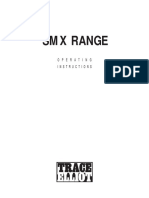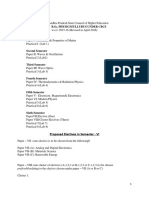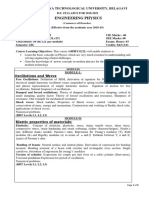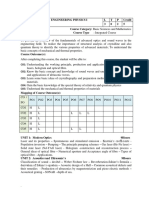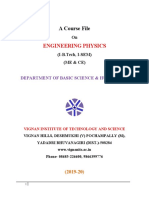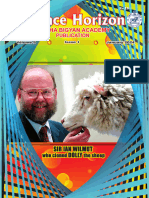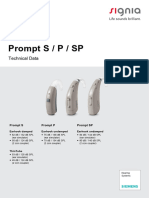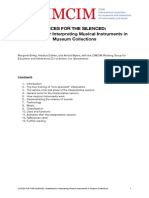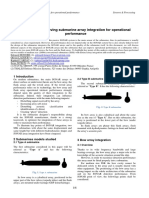BPHYC102
Uploaded by
Siddu KLEITBPHYC102
Uploaded by
Siddu KLEIT16-2-2023
Course Title: Applied Physics for CV Stream
Course Code: BPHYC102/202 CIE Marks 50
SEE Marks 50
Course Type (Theory/Practical/Integrated ) Integrated
Total Marks 100
Teaching Hours/Week (L:T:P: S) 2:2:2:0 Exam Hours 03
40 hours Theory + 10-12 Lab
Total Hours of Pedagogy Credits 04
slots
Course objectives
To understand the types of oscillation, shock waves & its generation, and applications.
To Study the elastic properties of materials and failures of engineering materials
To Study the acoustics buildings and the essentials of radiometry and photometry.
To understand the principles photonic devices and their application relevant to civil engineering.
To understand the various natural disaster and safety
Teaching-Learning Process
These are sample Strategies, which teacher can use to accelerate the attainment of the various course outcomes and
make Teaching –Learning more effective
1. Flipped Class
2. Chalk and Talk
3. Blended Mode of Teaching and Learning
4. Simulations, Interactive Simulations and Animations
5. NPTEL and Other Videos for theory topics
6. Smart Class Room
7. Lab Experiment Videos
Module-1 (8 Hours)
Module -I: Oscillations and Shock waves:
Oscillations: Simple Harmonic motion (SHM), Differential equation for SHM (No derivation), Sprigs: Stiffness
Factor and its Physical Significance, Series and Parallel combination of springs (Derivation), Types of Springs and
their applications. Theory of Damped oscillations (Qualitative), Types of Damping (Graphical Approach). Engineering
applications of Damped oscillations, Theory of Forced oscillations (Qualitative), Resonance, Sharpness of resonance.
Numerical Problems.
Shock waves: Mach number and Mach Angle, Mach Regimes, Definition and Characteristics of Shock waves,
Construction and working of Reddy Shock tube, Applications of Shock Waves, Numerical problems.
Pre-requisites: Basics of Oscillations
Self-learning: Simple Harmonic motion, Differential equation for SHM
Module-2 (8 Hours)
Elasticity
Stress-Strain Curve, Stress hardening and softening. Elastic Moduli, Poisson’s ratio, Relation between Y, n and σ (with
derivation), mention relation between K, Y and σ, limiting values of Poisson’s ratio. Beams, Bending moment and
derivation of expression, Cantilever and I section girder and their Engineering Applications, Elastic materials
(qualitative). Failures of engineering materials - Ductile fracture, Brittle fracture, Stress concentration, Fatigue and
factors affecting fatigue (only qualitative explanation), Numerical problems.
Pre requisites: Elasticity,Stress & Strain
Self-learning: Stress-Strain Curve
Module-3 (8 Hours)
Acoustics,RadiometryandPhotometry:
Acoustics: Introduction to Acoustics, Types of Acoustics, Reverberation and reverberation time, Absorption power
andAbsorption coefficient, Requisites for acoustics in auditorium, Sabine’s formula (derivation), Measurement of
absorptioncoefficient, Factors affecting the acoustics and remedial measures, Sound Insulation and itsmeasurements.
Noise and its Measurements, Impact of Noise in Multi-storied buildings.
1
16-2-2023
Radiometry and Photometry: Radiation Quantities, Spectral Quantities, Relation between luminance and
Radiantquantities, Reflectanceand Transmittance, Photometry (cosinelaw and inverse square law).
Prerequisites:BasicsofSound,Waves&lightproperties.
Self-learning:Introductiontoacoustics.
Module-4 (8 Hours)
Photonics:
LASER
Properties of a LASER Beam, Interaction of Radiation with Matter, LASER action, Population Inversion,
MetastableState,Requisites of a LASER System, Semiconductor LASER, LASER Range Finder, LIDAR, Road
Profiling, BridgeDeflection, SpeedChecker, NumericalProblems.
OpticalFiber
Principle and Construction of Optical Fibers, Acceptance angle and Numerical Aperture (NA), Expression for NA,
Modes of Propagation,Attenuation and Fiber Losses, Fiber Optic Displacement Sensor, Fiber Optic Temperature
Sensor, Numerical Problems
Pre requisite: Propertiesof light.
Self-learning: Total Internal Reflection.
Module-5 (8 Hours)
NaturalhazardsandSafety
Introduction, Earthquake, (general characteristics, Physics of earthquake, Richter scale of measurement and
earthquakeresistant measures), Tsunami (causes for tsunami, characteristics, adverse effects, risk reduction measures,
engineeringstructures to withstand tsunami), Landslide (causes such as excess rain fall, geological structure, human
excavation etc.,types of land slide, adverse effects, engineering solution for landslides). Forest Fires and detection
using remote sensing.Firehazardsandfireprotection,fire-
proofingmaterials,firesafetyregulationsandfirefightingequipment-Preventionandsafety measures.NumericalProblems.
Pre requisite: Oscillations.
Self-learning:Richterscale.
Course outcome (Course Skill Set)
At the end of the course the student will be able to:
CO1 Elucidate the concepts in oscillations, waves, elasticity and material failures
CO2 Summarize concepts of acoustics in buildings and explain the concepts in radiation and photometry
CO3 Discuss the principles photonic devices and their application relevant to civil engineering.
CO4 Describe the various natural hazards and safety precautions.
CO5 Practice working in groups to conduct experiments in physics and perform precise and honest measurements.
Assessment Details (both CIE and SEE)
The weightage of Continuous Internal Evaluation (CIE) is 50% and for Semester End Exam (SEE) is 50%. The minimum
passing mark for the CIE is 40% of the maximum marks (20 marks out of 50). The minimum passing mark for the SEE is
35% of the maximum marks (18 marks out of 50). A student shall be deemed to have satisfied the academic requirements
and earned the credits allotted to each subject/ course if the student secures not less than 35% (18 Marks out of 50) in the
semester-end examination(SEE), and a minimum of 40% (40 marks out of 100) in the sum total of the CIE (Continuous
Internal Evaluation) and SEE (Semester End Examination) taken together.
Continuous Internal Evaluation(CIE):
The CIE marks for the theory component of the IC shall be 30 marks and for the laboratory component 20 Marks.
CIE for the theory component of the IC
Three Tests each of 20 Marks; after the completion of the syllabus of 35-40%, 65-70%, and 90-100% respectively.
Two Assignments/two quizzes/ seminars/one field survey and report presentation/one-course project totalling 20
marks.
Total Marks scored (test + assignments) out of 80 shall be scaled down to 30 marks
CIE for the practical component of the IC
On completion of every experiment/program in the laboratory, the students shall be evaluated and marks shall be
2
16-2-2023
awarded on the same day. The 15 marks are for conducting the experiment and preparation of the laboratory
record, the other 05 marks shall be for the test conducted at the end of the semester.
The CIE marks awarded in the case of the Practical component shall be based on the continuous evaluation of the
laboratory report. Each experiment report can be evaluated for 10 marks. Marks of all experiments’ write-ups are
added and scaled down to 15 marks.
The laboratory test (duration 03 hours) at the end of the 15th week of the semester /after completion of all the
experiments (whichever is early) shall be conducted for 50 marks and scaled down to 05 marks.
Scaled-down marks of write-up evaluations and tests added will be CIE marks for the laboratory component of IC/IPCC
for 20 marks.
The minimum marks to be secured in CIE to appear for SEE shall be 12 (40% of maximum marks) in the theory
component and 08 (40% of maximum marks) in the practical component. The laboratory component of the
IC/IPCC shall be for CIE only. However, in SEE, the questions from the laboratory component shall be included.
The maximum of 05 questions is to be set from the practical component of IC/IPCC, the total marks of all ques-
tions should not be more than 25 marks.
The theory component of the IC shall be for both CIE and SEE.
Semester End Examination(SEE):
Theory SEE will be conducted by University as per the scheduled timetable, with common question papers for the subject
(duration 03 hours)
The question paper shall be set for 100 marks. The medium of the question paper shall be English/Kannada). The
duration of SEE is 03 hours.
The question paper will have 10 questions. Two questions per module. Each question is set for 20 marks. The
students have to answer 5 full questions, selecting one full question from each module. The student has to answer
for 100 marks and marks scored out of 100 shall be proportionally reduced to 50 marks.
There will be 2 questions from each module. Each of the two questions under a module (with a maximum of 3 sub-
questions), should have a mix of topics under that module.
Suggested Learning Resources:
Books (Title of the Book/Name of the author/Name of the publisher/Edition and Year)
1. Materials Science and Engineering by R Balasubramaniam, second edition, Wiley India Pvt. Ltd. Ansari Road,
Daryaganj, New Delhi-110002.
2. A Textbook of Engineering Physics by M .N. Avadhanulu, P G. Kshirsagar and T V S Arun Murthy, Eleventh
edition, S Chand and Company Ltd. New Delhi-110055.
3. Engineering Physics by R. K. Gaur and S. L. Gupta, 2010 edition, Dhanpat Rai Publications Ltd., New Delhi-110002,
4. Building Science: Lighting and Accoustics, B. P. Singh and Devaraj Singh, Dhanpat Rai Publications (P) Ltc.,
5. Building Acoustics : Tor Eric Vigran, Taylor and Francis, 2008 Edition.
6. Photometry Radiometry and Measurements of Optical Losses, Micheal Bukshtab, Springer, 2 nd edition.
7. Materials Science for Engineers by James F. Shackelford and Madanapalli K Muralidhara, sixth edition, Pearson
Education Asia Pvt. Ltd., New Delhi.
8. Lasers and Non Linear Optics, B B Loud, New Age Internationals, 2011 edition
9. Shock waves made simple by Chintoo S Kumar, K Takayama and K P J Reddy: Willey India Pvt. Ltd, Delhi 2014.
10. An Introduction to Disaster Management, Natural Disastr & Man Made Hazards, S. Vaidyanathan, IKON Books P
11. Natural Hazards, Edward Bryant, Cambridge University, Press, 2 nd Edition
12. Natural Hazards by Ramesh .P. Singh, CRC Press, Taylor and Francis group.
13. Disaster Education and Management, Rajendra Kumar Bhandari, Springer, India 2014
14. Principles of Fire Safety Engineering Understanding Fire & Fire Protection, Akhil Kumar Das, PHI Learning , II
Edition.
Web links and Video Lectures (e-Resources):
3
16-2-2023
Web links:
Simple Harmonic motion:https://www.youtube.com/watch?v=k2FvSzWeVxQ
Shock waves:https://physics.info/shock/
Shock waves and its applications:https://www.youtube.com/watch?v=tz_3M3v3kxk
Stress-strain curves:https://web.mit.edu/course/3/3.11/www/modules/ss.pdf
Stress curves:https://www.youtube.com/watch?v=f08Y39UiC-o
Oscillations and waves :https://openstax.org › books › college-physics-2e
Earthquakes:www.asc-india.org
Earthquakes and Hazards:http://quake.usgs.gov/tsunami
Landslide hazards:http://landslides.usgs.gov
Acoustics:https://www.youtube.com/watch?v=fHBPvMDFyO8
Activity Based Learning (Suggested Activities in Class)/ Practical Based learning
http://nptel.ac.in
https://swayam.gov.in
https://virtuallabs.merlot.org/vl_physics.html
https://phet.colorado.edu
https://www.myphysicslab.com
Laboratory Component:
Any Ten Experiments have to be completed from the list of experiments
Note: The experiments have to be classified into
a) Exercise
b) Demonstration
c) Structured Inquiry
d) Open Ended
Based on the convenience classify the following experiments into above categories. Select at least one
simulation/spreadsheet activity.
List of Experiments
1. Determination of Young’s modulus of the material of the given bar Uniform Bending.
2. Determination of Rigidity modulus of the Material of the wire using Torsional Pendulum.
3. Study of Forced Mechanical Oscillations and Resonance.
4. Study of the frequency response of Series & Parallel LCR circuits.
5. Determination of Fermi Energy of the given Conductor.
6. Determination of Resistivity by Four Probe Method.
7. Determination of effective spring constant of the given springs in series and parallel combinations.
8. Determination of Young’s modlus of the material of the given bar Single Cantilever.
9. Determination of the the Moment of Inertia of the given irregular body using torsional pendulum.
10. Determination of Wavelength of Laser using Diffraction Grating.
11. Determination of Acceptance angle and Numerical Aperture of the given Optical Fiber.
12. Determination of the Radius of Curvature of the given Plano Convex Lens by setting Newton’s Rings.
13. Step Interactive Physical Simulations.
14. Study of motion using spread Sheets
15. Application of Statistics using Spread Sheets.
16. PHET Interactive Simulations :
(https://phet.colorado.edu/en/simulations/filter?subjects=physics&type=html,prototype)
4
16-2-2023
COs and POs Mapping (Individual teacher has to fill up)
POs
COs
1 2 3 4 5 6 7 8 9 10 11 12
CO1 3 2 - - 1 - - - - - - 2
CO2 3 2 - - - - - - - - - 2
CO3 3 2 - - - - - - - - - 2
CO4 3 3 - - - 1 - - - - - 2
CO5 3 2 1 - 2 - - 3 3 - - 2
Level 3- Highly Mapped, Level 2-Moderately Mapped, Level 1-Low Mapped
Note : The CO-PO mapping values are indicative. The course coordinator can alter the mapping using Competency and
Performance Indicators mentioned in the AICTE Exam reforms
You might also like
- PHYSC111-College Physics 1 Syllabus-Spring2013No ratings yetPHYSC111-College Physics 1 Syllabus-Spring20136 pages
- The Art of Mixing Visual Representations of SoundNo ratings yetThe Art of Mixing Visual Representations of Sound30 pages
- Physics For Civil Stream (22phyc12 or 22)No ratings yetPhysics For Civil Stream (22phyc12 or 22)3 pages
- 22PH101-CE-Unit 1. WAVES AND OSCILLATIONSNo ratings yet22PH101-CE-Unit 1. WAVES AND OSCILLATIONS58 pages
- 2022 First Semester Scheme Syllabus CV Stream Physics CycleNo ratings yet2022 First Semester Scheme Syllabus CV Stream Physics Cycle17 pages
- EEE PHY 111 (Theory) OBE Course Outline & Lecture PlanNo ratings yetEEE PHY 111 (Theory) OBE Course Outline & Lecture Plan4 pages
- B.SC Physics Syllabus (Semester Wise) 2015No ratings yetB.SC Physics Syllabus (Semester Wise) 201565 pages
- Model Curriculum Diploma Mechanical Engineering 040912No ratings yetModel Curriculum Diploma Mechanical Engineering 040912213 pages
- B.tech Civil Details Curriculum As Per NEP 2023 W.E.F 2023-24-1694930910No ratings yetB.tech Civil Details Curriculum As Per NEP 2023 W.E.F 2023-24-169493091044 pages
- REVISED SYLLABUS-ASH DEPT B.TECH ECE AI CSE AI AI ML (1)No ratings yetREVISED SYLLABUS-ASH DEPT B.TECH ECE AI CSE AI AI ML (1)18 pages
- BFT PHY 111 (Theory) OBE Course Outline & Lecture PlanNo ratings yetBFT PHY 111 (Theory) OBE Course Outline & Lecture Plan4 pages
- Updated-Engineering Physics- CU Course Hanbook-12.12.2024 (2) (1)No ratings yetUpdated-Engineering Physics- CU Course Hanbook-12.12.2024 (2) (1)11 pages
- COURSEFILE@ENGINEERING PHYSICS-19-20-sem 1No ratings yetCOURSEFILE@ENGINEERING PHYSICS-19-20-sem 136 pages
- RC2019 20 FirstYear Engg Scheme SyllabusNo ratings yetRC2019 20 FirstYear Engg Scheme Syllabus28 pages
- CoES Course Plan 2017 Exploration GeophysicsNo ratings yetCoES Course Plan 2017 Exploration Geophysics9 pages
- NewSyllabus_22e7ed6c-ede0-4202-8942-f5a43d3e339dNo ratings yetNewSyllabus_22e7ed6c-ede0-4202-8942-f5a43d3e339d5 pages
- Course - Outline - PHY 161 - NAME - L1T2No ratings yetCourse - Outline - PHY 161 - NAME - L1T24 pages
- First Year B Tech Syllabus (NEP Compliant)No ratings yetFirst Year B Tech Syllabus (NEP Compliant)38 pages
- Engineering Physics B (For Non-Circuit Branches) : Category L T P Credit Year ofNo ratings yetEngineering Physics B (For Non-Circuit Branches) : Category L T P Credit Year of10 pages
- Fracture Toughness of Cement Paste Assessed With MicroScratch and Acoustic EmissionNo ratings yetFracture Toughness of Cement Paste Assessed With MicroScratch and Acoustic Emission7 pages
- SCIENCE HORIZON NOV 2023 - Compressed CompNo ratings yetSCIENCE HORIZON NOV 2023 - Compressed Comp52 pages
- The Importance of Vocal Tract Resonance in Clarinet and Saxophone Performance, A Preliminary AccountNo ratings yetThe Importance of Vocal Tract Resonance in Clarinet and Saxophone Performance, A Preliminary Account5 pages
- Deterministic Aero-Vibro Acoustics (Dava) - Implementation of Dava Simulation in Three StepsNo ratings yetDeterministic Aero-Vibro Acoustics (Dava) - Implementation of Dava Simulation in Three Steps4 pages
- ANSYS Mechanical APDL Acoustic Analysis Guide100% (1)ANSYS Mechanical APDL Acoustic Analysis Guide94 pages
- Bose Panaray 502 A, 502 B, and 502 BEX Loudspeakers: Technical InformationNo ratings yetBose Panaray 502 A, 502 B, and 502 BEX Loudspeakers: Technical Information4 pages
- Underwater Acoustic Noise Measurement of VesselsNo ratings yetUnderwater Acoustic Noise Measurement of Vessels6 pages
- Focal Catalog Bespoke Integrated Solutions - 12 - 2022 - en - WebNo ratings yetFocal Catalog Bespoke Integrated Solutions - 12 - 2022 - en - Web65 pages
- Voices For The Silenced: Guidelines For Interpreting Musical Instruments in Museum CollectionsNo ratings yetVoices For The Silenced: Guidelines For Interpreting Musical Instruments in Museum Collections10 pages
- Decibel (Loudness) Comparison Chart: Environmental NoiseNo ratings yetDecibel (Loudness) Comparison Chart: Environmental Noise2 pages
- (PDF Download) Introduction To Sonar Transducer Design John C Cochran Fulll Chapter100% (4)(PDF Download) Introduction To Sonar Transducer Design John C Cochran Fulll Chapter64 pages
- 1982 Bookmatter EssentialsOfMedicalUltrasoundNo ratings yet1982 Bookmatter EssentialsOfMedicalUltrasound25 pages
- Compendium of Surface and Interface Analysis 1st Edition The Surface Science Society of Japan (Eds.) 2024 Scribd Download100% (3)Compendium of Surface and Interface Analysis 1st Edition The Surface Science Society of Japan (Eds.) 2024 Scribd Download62 pages


